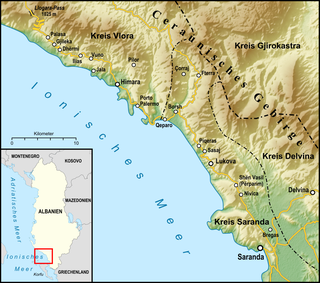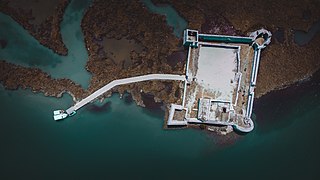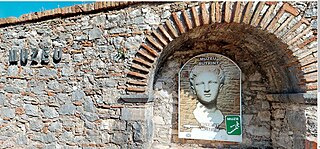
The Peloponnese, Peloponnesus or Morea is a peninsula and geographic region in Southern Greece, and the southernmost region of the Balkans. It is connected to the central part of the country by the Isthmus of Corinth land bridge which separates the Gulf of Corinth from the Saronic Gulf. From the late Middle Ages until the 19th century, the peninsula was known as the Morea, a name still in colloquial use in its demotic form.

Butrint was an ancient Greek polis and later Roman city and the seat of an early Christian bishopric in Epirus.

Tourism in Albania has been a key element to the country's economic activity and is constantly developing. Albania is characterized by its rich archaeological and cultural heritage dating back to the classical period when Illyrians and Ancient Greeks inhabited the region. Over the course of history, the territory of Albania was occupied and populated by Romans, Byzantines, Venetians and Ottomans. Notably the country features unspoiled beaches, mountainous landscapes, traditional cuisine, archaeological artifacts, unique traditions, low prices and the wild atmosphere of the countryside.

Vlorë County is one of the 12 counties of Albania with the city of Vlorë being the county capital. The county spans 2,706 square kilometres (1,045 sq mi) and has a total population of 146,681 people as of 2023. It borders the counties of Fier and Gjirokastër, as well as the Adriatic and Ionian Sea. Greece borders Vlorë to the south.

Parga is a town and municipality located in the northwestern part of the regional unit of Preveza in Epirus, northwestern Greece. The seat of the municipality is the village Kanallaki. Parga lies on the Ionian coast between the cities of Preveza and Igoumenitsa. It is a resort town known for its natural environment.

The Despotate of the Morea or Despotate of Mystras was a province of the Byzantine Empire which existed between the mid-14th and mid-15th centuries. Its territory varied in size during its existence but eventually grew to include almost all the southern Greek peninsula now known as the Peloponnese, which was known as the Morea during the medieval and early modern periods. The territory was usually ruled by one or more sons of the current Byzantine emperor, who were given the title of despotes. Its capital was the fortified city of Mystras, near ancient Sparta, which became an important centre of the Palaiologan Renaissance.

Butrint National Park is a national park in Vlorë County, southern Albania. It is located 18 kilometres (11 mi) south of Sarandë. The park encompasses 9,424 hectares (94.24 km2) of hilly terrain with freshwater lakes, wetlands, salt marshes, open plains, reed beds and islands. The park's significance for conservation is reflected in the large number of species with over 1,200 different animals and plants. Its mandate includes the protection of the lake and lagoon of Butrint, the natural channel of Vivari, the islands of Ksamil and as well the archaeological site, that provides valuable remains of ancient civilisations.

The Vivari Channel links Lake Butrint in the extreme south of Albania with the Straits of Corfu, and forms a border of the peninsula of Butrint.

The Frankokratia, also known as Latinokratia and, for the Venetian domains, Venetokratia or Enetokratia, was the period in Greek history after the Fourth Crusade (1204), when a number of primarily French and Italian states were established by the Partitio terrarum imperii Romaniae on the territory of the dismantled Byzantine Empire.

The Albanian Riviera, also popularly known as Bregu, is a coastline along the north-eastern Ionian Sea in the Mediterranean Sea, encompassing the districts of Sarandë and Vlorë in south-western Albania. It forms an important section of the Albanian Ionian Sea Coast, dotted with the villages of Palasë, Dhërmi, Vuno, Himara, Qeparo, Borsh, Piqeras, Lukovë, and the city of Sarandë.

Butrint Lagoon is a salt lagoon south of Saranda, Albania, located in direct proximity of the Ionian Sea. It is surrounded by dense forested hills, rocky coast and complemented by saltwater and freshwater marshlands. The lake has a length of 7.1 km (4.4 mi) and a width of 3.3 km (2.1 mi), with a surface area of 16 km2 (6.18 sq mi). The maximum depth of the lake is 24.4 m (80 ft). At the south, the Vivari Channel connects the lagoon to the sea.

Borsh Castle also known as Sopot Castle from the hill it is located, is a historic castle near the village Borsh, Albania, near the coast of the Ionian Sea. The only standing building inside the castle is the 17th-century Hajji Bendo Mosque from Ottoman times which is now in a ruined state.

Ali Pasha Castle is a castle in Albania. It is named after Ali Pasha of Tepelenë who resided there until 1820. The current fortress was rebuilt in 1819 from its surface with 3 towers. Until 1820 it was the second residence of Ali Pashe Tepelena.
Palaiokastro is a coastal village and a community in the municipality of Malevizi. 9 km west of Heraklion on the island of Crete. It is situated in front of a 70 meter long pebbled beach leading to a cove with rapidly deepening waters that are protected from the prevailing northerly winds. On the southern end of the beach rises a steep calcareous rock. During the Venetian occupation of Crete extensive fortifications were built on this rock, housing cannons that secured the bay of Heraklion. Ruins of the fortress walls survive until today.

The architecture of Albania is a reflection of Albania's historical and cultural heritage. The country's architecture was influenced by its location within the Mediterranean Basin and progressed over the course of history as it was once inhabited by numerous civilisations including the Illyrians, Ancient Greeks, Romans, Byzantines, Venetians, Ottomans as well as modern Austro-Hungarians and Italians. In addition, missionaries, invaders, colonisers and traders brought cultural changes that had a large profound effect on building styles as well as techniques.

The Porto Palermo is a bay in southwestern Albania. In the middle of the bay there is a small peninsula, it connection to the mainland serves as a parking space for campers and it has sandy beach.
The anti-Ottoman revolts of 1567-1572 were a series of conflicts between Albanian, Greek and other rebels and the Ottoman Empire during the early period 16th century. Social tensions intensified at this time by the debilitation of the Ottoman administration, the chronic economic crisis, and arbitrary conduct of the Ottoman state authorities. The leaders of the uprisings were initially successful and controlled several strategic locations and fortresses, especially in Epirus, Central Greece, and the Peloponnese. However, the movement lacked the necessary organization. They were instigated and assisted by western powers; mainly by the Republic of Venice, and the victory of the Holy League against the Ottoman fleet in the Battle of Lepanto, in November 1571, triggered further revolutionary activity. However, Venice withdrew its support to the rebels and signed a unilateral peace with the Ottomans. As such the rebellions were doomed to end and the Ottoman forces committed a number of massacres in the aftermath of the revolt during the suppression of the uprising. Throughout the pacification process, various primarily isolated areas were still out of Ottoman control and new rebellions erupted, like that of Dionysios Skylosophos in 1611.

The Archaeological Museum of Butrint was opened in 1938. It was reopened during the 1950s-1960s in the premises of the Venetian Acropolis Castle within the acropolis of the ancient city. It containes the Graeco-Roman archaeological finds from the Italian Archaeological Mission of the period between the two World Wars, led by Luigi Maria Ugolini.

The Venetian Triangular Castle is a castle near Butrint. The castle is located by the Channel of Vivari nearby Butrint National Park.





















